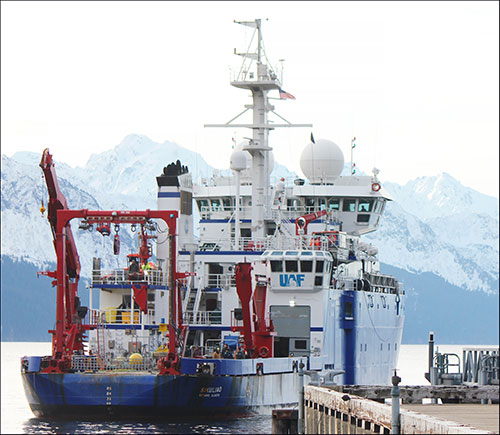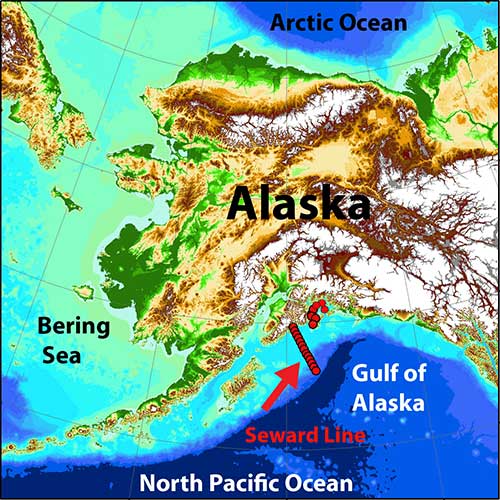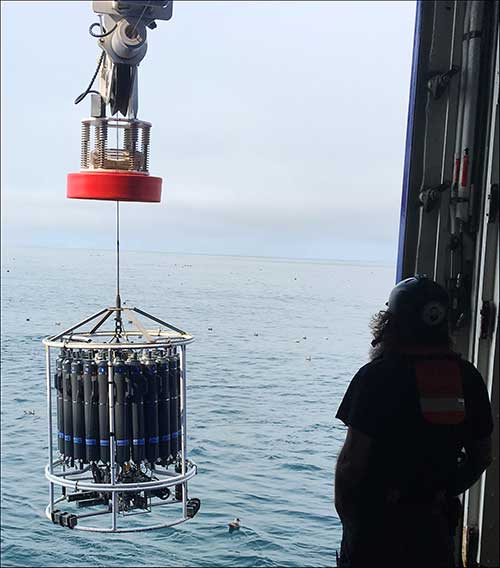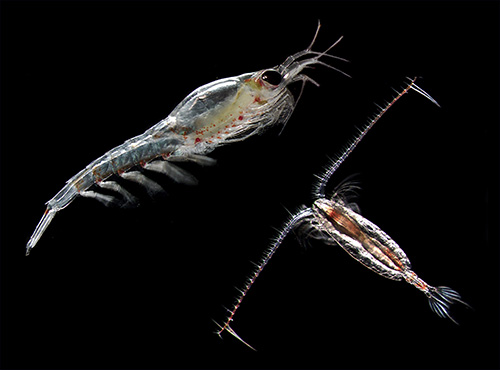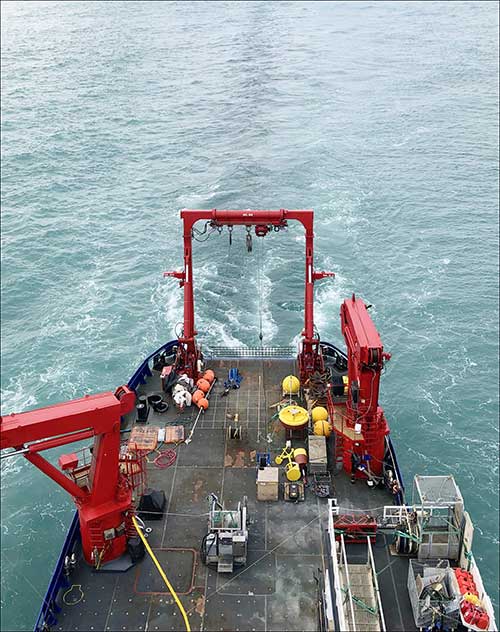
Sikuliaq embarks on limited research cruiseBy ALICE BAILEY
May 04, 2020
Special permission has been granted for a small team of researchers from the College of Fisheries and Ocean Sciences at the University of Alaska Fairbanks to collect water samples in the northern Gulf of Alaska. This will mark the first time a vessel in the U.S. Academic Research Fleet has been allowed to engage in research activities since COVID-19 grounded the fleet, which is coordinated by the University-National Oceanographic Laboratory System.
The scientists self-quarantined for two weeks prior to boarding the vessel, and are adhering to health mandates while conducting their research. Rose Dufour, ship operations program director at the National Science Foundation, said, “NSF recognizes the difficult decision to move forward with science operations in these uncertain times, but we feel UAF has done an excellent job in assessing and mitigating the risks.” UAF operates the Sikuliaq on behalf of NSF, which owns the vessel. The Sikuliaq will provide science support for the Northern Gulf of Alaska Long-Term Ecological Research program. This ocean region supports one of the nation’s largest fisheries, as well as many important crab, seabird and marine mammal populations. Understanding the NGA ecosystem begins with understanding the plankton that sustain it.
“The explosion of life during spring sets up much of the productivity for the entire year,” explained Russ Hopcroft, the lead principal investigator of CFOS research for the NGA LTER. The cruise was originally scheduled for two weeks in April with 24 scientists and two technicians, in addition to the full-time crew already on the 261-foot vessel. The plan was to travel from Seward for 170 miles south of Resurrection Bay along a series of sample sites called the Seward Line. Researchers have been recording observations in this area twice a year since 1997, making it the longest data set of this type in Alaska waters. Leaders at NSF, UNOLS and UAF agreed that this research was sufficiently important to consider alterations to the cruise plan that would be compatible with COVID-19 safety precautions. A detailed mitigation and response plan was created with guidance from the U.S. Coast Guard, UNOLS, the World Health Organization, the Centers for Disease Control and health mandates issued by Alaska’s governor. “We have reduced our planned two-week cruise to one week, and we will never be more than a day away from home port,” said Hopcroft. “We think that with three scientists we can cover all of the core measurements that we have been taking for the last two decades.” Having a minimal science team will promote social distancing in the labs and on deck to the fullest extent possible, and everyone will have their own room and bathroom facilities.
“The density of personnel on board is such that we can spread everybody out,” said Doug Baird, the Sikuliaq’s marine superintendent. The researchers will focus on measurements that are part of the two-decade time series. They will collect phytoplankton and zooplankton and take water column measurements showing the ocean’s temperature, salinity, oxygen, chlorophyll and nutrients. “Spring is a key time of the year in the Gulf of Alaska, and being able to obtain measurements of some core parameters will retain the integrity of the time series,” said Ana Aguilar-Islas, one of the scientists going on the cruise.
Shipboard experiments, seabird and mammal surveys, jellyfish sampling, dissolved iron and other trace metal sampling, carbonate chemistry sampling, optical measurements, and many other activities will have to wait. “We are stepping up to sample for our colleagues where possible,” said Seth Danielson, the third scientist going on the cruise. “And we will rely more heavily than usual on our outstanding marine technicians and crew.” To prepare for the cruise, the crew has been cleaning common surfaces twice daily and are monitoring their temperatures and oxygen levels twice daily. Hopcroft, Aguilar-Islas and Danielson have been recording their temperatures while they are in quarantine at home. Everyone participating in the cruise is required to communicate to the ship’s medical officer any change in their health condition, which includes any signs or symptoms of COVID-19.
The scientists drove personal vehicles from Fairbanks to Seward. “We can travel from Fairbanks directly to the ship without any public contact that risks infection along the way,” Hopcroft said. The health safety plans for this cruise have been shared with other research fleet vessel operators to assist with future seagoing research operations as they adapt to the pandemic. “We are very pleased to have the support of NSF, UNOLS and university senior leadership for this important scientific operation,” said CFOS Dean Bradley Moran. “I am proud of the diligence of the entire ship operations staff in their efforts to ensure the health and safety of ship personnel and scientists as they work to conduct important research that benefits Alaska.”
|
|||||||||
